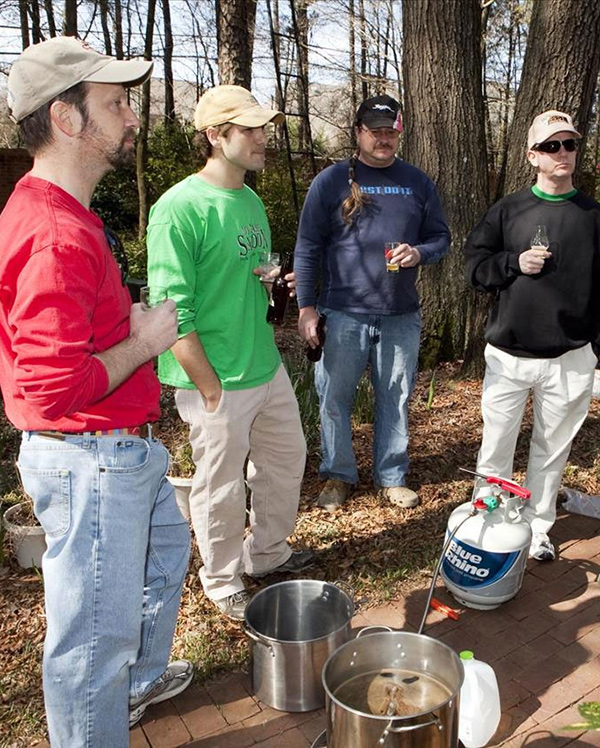
A thriving homebrew club is an excellent venue through which to learn from other homebrewers, discover new tips and techniques, and share your passion for great handcrafted beer. But good clubs don’t just happen: they take hard work and planning. Fortunately, it’s easy to motivate your members with just a little extra attention to consistency, education, and community.
Every club is unique, but a few things have worked particularly well for my club, the Carolina BrewMasters (CBM). In this, the first of a two-part article, I’ll share some of the successful strategies we’ve employed at CBM.
Be Consistent
Holding regularly scheduled—and regular is key—club meetings is the number one way to encourage involvement. Meetings give your members an opportunity to connect with one another, get updates on the club, and share great homebrew. Make your meetings easy to remember by consistently holding them at the same day, time, and location. For example, our CBM club meetings always take place on the first Wednesday of every month at 6:30pm, at Dilworth Neighborhood Grille in downtown Charlotte, N.C.
Inviting guests to your meetings can be a great way to recruit potential members. Our club does not require that attendees be official paid members to come to CBM meetings, but we do encourage new faces to join. We find that about 10 to 15 percent of our 90 to 110 monthly attendees are first-time visitors. Encourage them to return!
Hold annual elections for officers to promote fresh ideas from fresh faces. Electing new officers each year avoids burning out your core group of regulars and affords all members a chance to share their talents. Prepare and periodically revise a document that outlines the rules and expectations for your club. Yours might include bylaws, a code of conduct, or a simple mission statement. What matters most is setting expectations of predictability and transparency.
Offer a clear vision of what your club is about, and charge dues. Even a modest financial commitment holds members responsible and makes then more likely to attend. And don’t forget to protect your club and its members with insurance, which is easier than ever thanks to affordable insurance made available by the American Homebrewers Association.
Have a convenient way to communicate with your members. This can be through a website, an email distribution list, or social media channels like Twitter and Facebook. Some clubs use event organizers like Evite or SignUp Genius, while others create custom platforms for getting the word out. Communicate clearly and frequently, but don’t overwhelm your members with tons of email.
Hold regular brew sessions
Brew days are great opportunities to share what you know, learn something new, and get to know other members. Our sessions at CBM cover everything from extract kits on the stovetop to 15-gallon all-grain creations. If you host your brew days at private homes, change up locations so that members can learn about different kinds of equipment and brewing styles.
Our club members live in an area that spans more than 300 square miles (777 square kilometers). Thus, moving our brew sessions around the city each month gives everyone an opportunity to brew in a location convenient to where they live and work. We make chili in the winter, host pool parties in the summer, brew in a garage in the rain, and play ping pong in the backyard or driveway. Varying the entertainment along with the location keeps things interesting and prevents staleness.
If none of your members wants to host, ask your local homebrew supply store or a local brewery with homebrewing roots if you can use their space. Even if you only brew quarterly or biannually, a group brew day gets your members together and brings new customers to the host store or brewery.
Brew sessions are also a great opportunity to include the entire family in the hobby you love, so don’t limit yourself to brewing just beer. My son enjoys making root beer for his birthday party and is proud to share it with his friends.
Educate Your Members
Our club allocates about 20 minutes at each meeting to offer a member the chance to give a presentation on a topic. Start basic, with familiar topics like hops, water, malt, and yeast, before getting too advanced. If you don’t have members that want to present, then reach out to the national brewing community and utilize services like Skype and Google Hangouts.
Have experienced judges offer feedback to members at your meetings. This might be anything from choosing the right competition category to eliminating off-flavors. Encourage your members to become BJCP-trained judges by holding study sessions, publicizing exam dates and details, and paying for exam fees and travel expenses if your club can afford it.
A BJCP-sanctioned competition can be a great fundraiser for your club and a wonderful educational venue. Our annual competition collects around 500 entries, covers three days, has more than 45 judges and 25 stewards, and engages countless volunteers. Hold club-only competitions as well, and as an added bonus, ask local breweries if they could brew the winning recipes from a competition or two and serve it in their taprooms.
Encourage your members to compete in events throughout the year. Our club collects and ships competition entries together to save shipping costs and to help those who aren’t sure how to appropriately wrap bottles and package them. The more your members compete and receive feedback, the better they’ll brew, and the more they’ll want to learn.
But wait, there’s more!
There are so many great ways to encourage club members to participate that we couldn’t fit them all in one article. So be sure to check out for the second installment of How to Motivate Member Participation in Your Homebrew Club!
* * *
Lauren Domm is a member of the Carolina BrewMasters homebrew club. The Carolina BrewMasters earned the AHA’s Radegast Club of the Year Award in 2014 for their outstanding service to their community.





Share Post